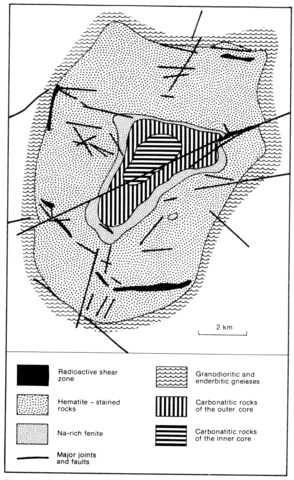stripes
Situated in the transition zone between Archaean granulites to the south and Proterozoic gneisses of the Nagssugtoqidian mobile belt to the north, the Sarfartoq carbonatite comprises a 15 km2 core of carbonatites and fenites surrounded by an extensive marginal zone containing carbonatite dykes. Although generally cutting across the foliation of the country rocks, in a zone 50-200 m wide adjacent to the core the foliation of the gneisses becomes concordant with the contact. The core carbonatites form sheets concentric with the core margin and separated by fenite screens. The inner core consists of more than 50% carbonatite, the outer core of less than 50% carbonatite, and this in turn is enveloped in a narrow zone of fenite. The transition to the marginal zone is gradual over 50-20 m. The core carbonatite is predominantly rauhaugite with minor lenses of sovite, with a foliation defined by concentrations of dark minerals, notably magnetite and phlogopite. A ground magnetic survey (Secher and Thorning, 1982) indicates that a large mass of sovite may form part of the inner core. The rauhaugite consists predominantly of dolomite with subordinate apatite, tetraferriphlogopite, magnetite, richterite-magnesio-arfvedsonite and accessory zircon, ilmenite, pyrochlore and pyrite. The fenites comprise alkali feldspar, aegirine, biotite and hornblende-magnesio-arfvedsonite, with minor calcite and pyrochlore. The rocks of the marginal zone have a red colour caused by the presence of hematite, and locally radioactive shear zones 50-200 m wide lie tangentially to the core. Zones of pyrochlore-rich rock 1-5 m wide are also orientated tangentially. There are numerous 5-100 cm wide dykes of beforsite, carbonatitic breccias and agglomerates, as well as lamprophyres and numerous carbonate veins. Around the complex and up to 20 km from it are abundant dykes dipping at 30-50° towards Sarfartoq (Larsen, 1980, Figs 20 and 21). They contain phlogopite and olivine phenocrysts with varying combinations of clinopyroxene, opaques, carbonate and rare garnet. Some of the dykes may be related to the Holsteinsborg occurrence (No. 25). Analyses of carbonatites, with trace elements including REE data, and of some minerals are given by Secher and Larsen (1980).
LARSEN, L.M. 1980. Lamprophyric and kimberlitic dykes associated with the Sarfartoq carbonatite complex, southern West Greenland. Rapport, Gronlands Geologiske Undersogelse, 100: 65-9.
LARSEN, L.M., REX, D.C. and SECHER, K. 1983. The age of carbonatites, kimberlites and lamprophyres from southern West Greenland: recurrent alkaline magmatism during 2500 million years. Lithos, 16: 215-21.
SECHER, K. in press a. Exploration of the Sarfartoq carbonatite complex, southern West Greenland. Rapport, Gronlands Geologiske Undersogelse..
SECHER, K. in press b. Phosphate resources in the Sarfartoq carbonatite complex, southern West Greenland. In R.P. Sheldon and A.J.G. Notholt (eds). Phosphate deposits of the World. 2. Cambridge University Press.
SECHER, K. and LARSEN, L.M. 1980. Geology and mineralogy of the Sarfartoq carbonatite complex, southern West Greenland. Lithos, 13: 199-212.
SECHER, K. and THORNING, L. 1982. Detailed ground magnetic survey in the central part of the Sarfartoq carbonatite complex, southern West Greenland. Rapport, Gronlands Geologiske Undersogelse, 110: 32-8.

